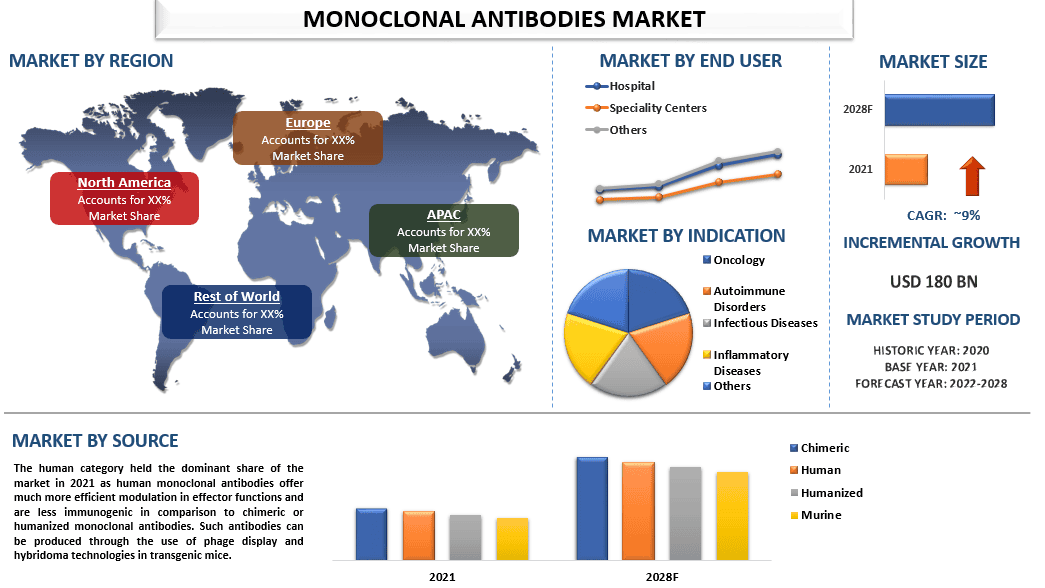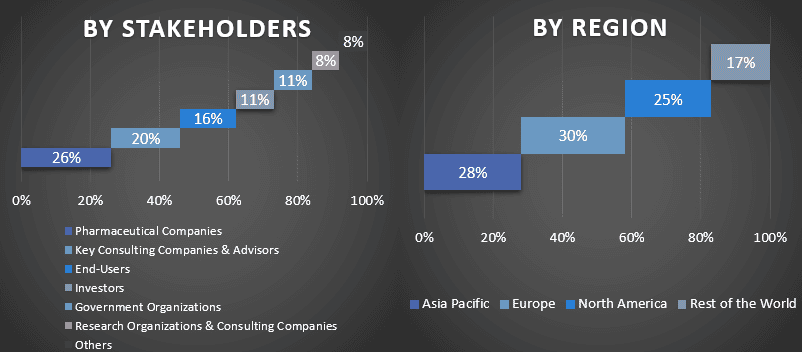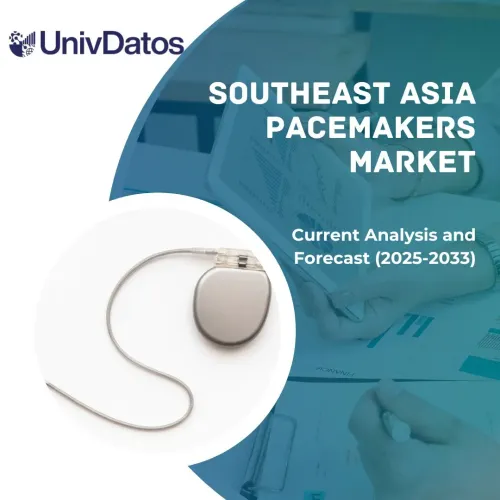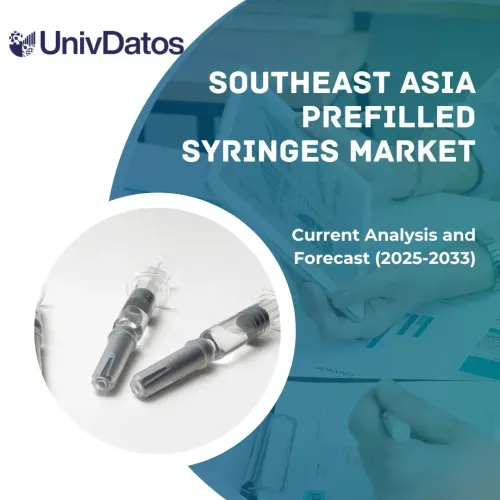- Home
- About Us
- Industry
- Services
- Reading
- Contact Us
Monoclonal Antibodies Market: Current Analysis and Forecast (2022-2028)
Emphasis on Source (Chimeric, Human, Humanized, and Murine); Indication (Oncology, Autoimmune Diseases, Infectious Diseases, Inflammatory Diseases, and Others); End User (Hospital, Specialty Centers, and Others); Region/Country

The monoclonal antibodies market is expected to grow at a strong CAGR of around 9% during the forecast period owing to the surge in the incidence of cancers, rising research and development activities for the development of novel monoclonal antibodies, and the development of a novel pipeline of monoclonal antibodies. Moreover, getting approvals for many new monoclonal antibodies by the respective authorities is more efficient and easy. For instance, In January 2021, the antibody-drug conjugate trastuzumab deruxtecan has been granted conditional approval in the European Union for use as a single agent in the treatment of adult patients with unresectable or metastatic HER2-positive breast cancer. Apart from this, the presence of various government and non-government organizations that aim to enhance awareness and promote research is also propelling market growth. For instance, Cancer Research Institute funded more than 120 clinical trials and invested around USD 474 million in research in 2020. In addition to this, the increasing funding from government organizations for cancer-related searches is also driving the monoclonal antibodies market.
Some of the major players operating in the market include AbbVie Inc.; F. Hoffmann-La Roche Ltd; Amgen Inc.; Pfizer Inc.; Bristol-Myers Squibb Company; Bayer AG; AstraZeneca; Sanofi; Merck & Co., Inc; and Johnson & Johnson Private Limited. Several M&As along with partnerships have been undertaken by these players to facilitate customers with hi-tech and innovative products/technologies.
Insights Presented in the Report
“Amongst source, the human segment held a significant share of the market in 2021”
Based on source, the market is segmented into chimeric, human, humanized, and murine. The human category held the dominant share of the market in 2021 as human monoclonal antibodies offer much more efficient modulation in effector functions and are less immunogenic in comparison to chimeric or humanized monoclonal antibodies. Such antibodies can be produced through the use of phage display and hybridoma technologies in transgenic mice. As a result, with recent technological progress in genetic engineering, the production of fully human monoclonal antibodies is anticipated to grow with high CAGR in the forthcoming years.
“Amongst indication, the autoimmune diseases category to grow with high CAGR during the forecast period”
By indication, the market is categorized into oncology, autoimmune diseases, infectious diseases, inflammatory diseases, and others. Autoimmune diseases is anticipated to grow with significant CAGR during the forecast period majorly due to the increase in the prevalence of rheumatoid arthritis and a large number of ongoing clinical trials. For instance, in March 2023, Enthera Pharmaceutical initiated phase-I clinical trial evaluating Ent001 or selected autoimmune conditions. Ent001 is a monoclonal antibody (mAb) targeting the IGFBP3/TMEM219 pathway, which plays a critical role in both inflammatory bowel disease (IBD) and type 1 diabetes (T1D).
“Amongst end user, the hospital segment held a dominant share of the market in 2021”
Based on end user, the market is segmented into hospital, specialty centers, and others. The hospitals held dominant share of the market in 2021 owing to rising hospital admissions due to surge in the prevalence of arious chronic diseases like cancer, autoimmune diseases, and rheumatoid arthritis among the population. Other factors, including increasing healthcare expenditure, rising patient awareness levels, and availability of advanced hospital infrastructure in developed countries are factors expected to result in the dominance of the segment during the forecast period.
“APAC to grow with high CAGR during the forecast period”
APAC is expected to grow with the highest CAGR during the forecast period. Several factors, such as rising disposable income, a large patient pool, and rising research and development activities are driving the regional market growth. Countries such as India and China offer attractive investment opportunities for clinical research and are anticipated to positively drive research and development prospects for monoclonal antibodies. In addition to this, rising product approvals will also propel the market growth. For instance, in January 2023, the National Medical Products Administration (NMPA) of China granted approval to Shanghai Henlius Biotech’s monoclonal antibody Hansizhuang in combination with carboplatin and etoposide to manage extensive stage small cell lung cancer (ES-SCLC).
Monoclonal Antibodies Market Report Coverage
| Report Attribute | Details |
| Base year | 2021 |
| Forecast period | 2022-2028 |
| Growth momentum | Accelerate at a CAGR of 9% |
| Market size 2021 | USD 180 billion |
| Regional analysis | North America, Europe, APAC, Rest of the World |
| Major contributing region | Asia-Pacific is expected to grow at the highest CAGR during the forecasted period |
| Key countries covered | U.S., Canada, Germany, United Kingdom, Spain, Italy, France, China, Japan, and India |
| Companies profiled | AbbVie Inc.; F. Hoffmann-La Roche Ltd; Amgen Inc.; Pfizer Inc.; Bristol-Myers Squibb Company; Bayer AG; AstraZeneca; Sanofi; Merck & Co., Inc; and Johnson & Johnson Private Limited. |
| Report Scope | Market Trends, Drivers, and Restraints; Revenue Estimation and Forecast; Segmentation Analysis; Impact of COVID-19; Demand and Supply Side Analysis; Competitive Landscape; Company Profiling |
| Segments Covered | By Source; By Indication; By End User; By Region/Country |
Reasons to buy this report:
- The study includes market sizing and forecasting analysis validated by authenticated key industry experts.
- The report presents a quick review of overall industry performance at one glance.
- The report covers an in-depth analysis of prominent industry peers with a primary focus on key business financials, product portfolios, expansion strategies, and recent developments.
- Detailed examination of drivers, restraints, key trends, and opportunities prevailing in the industry.
- The study comprehensively covers the market across different segments.
- Deep dive regional level analysis of the industry.
Customization Options:
The global monoclonal antibodies market can further be customized as per the requirement or any other market segment. Besides this, UMI understands that you may have your own business needs, hence feel free to connect with us to get a report that completely suits your requirements.
Table of Content
Research Methodology for the Monoclonal Antibodies Market Analysis (2022-2028)
Analyzing the historical market, estimating the current market, and forecasting the future market of the global monoclonal antibodies market were the three major steps undertaken to create and analyze the adoption of monoclonal antibodies in major regions globally. Exhaustive secondary research was conducted to collect the historical market numbers and estimate the current market size. Secondly, to validate these insights, numerous findings and assumptions were taken into consideration. Moreover, exhaustive primary interviews were also conducted, with industry experts across the value chain of the global monoclonal antibodies market. Post assumption and validation of market numbers through primary interviews, we employed a top-down/bottom-up approach to forecasting the complete market size. Thereafter, market breakdown and data triangulation methods were adopted to estimate and analyze the market size of segments and sub-segments of the industry pertains to. Detailed methodology is explained below:
Analysis of Historical Market Size
Step 1: In-Depth Study of Secondary Sources:
Detail secondary study was conducted to obtain the historical market size of the monoclonal antibodies market through company internal sources such as annual reports & financial statements, performance presentations, press releases, etc., and external sources including journals, news & articles, government publications, competitor publications, sector reports, third-party database, and other credible publications.
Step 2: Market Segmentation:
After obtaining the historical market size of the monoclonal antibodies market, we conducted a detailed secondary analysis to gather historical market insights and share for different segments & sub-segments for major regions. Major segments are included in the report as source, indication, and end user. Further country-level analyses were conducted to evaluate the overall adoption of testing models in that region.
Step 3: Factor Analysis:
After acquiring the historical market size of different segments and sub-segments, we conducted a detailed factor analysis to estimate the current market size of the monoclonal antibodies market. Further, we conducted factor analysis using dependent and independent variables such as drug class, therapy, indication, and distribution channel of the monoclonal antibodies market. A thorough analysis was conducted for demand and supply-side scenarios considering top partnerships, mergers and acquisitions, business expansion, and product launches in the monoclonal antibodies market sector across the globe.
Current Market Size Estimate & Forecast
Current Market Sizing: Based on actionable insights from the above 3 steps, we arrived at the current market size, key players in the global monoclonal antibodies market, and market shares of the segments. All the required percentage shares split, and market breakdowns were determined using the above-mentioned secondary approach and were verified through primary interviews.
Estimation & Forecasting: For market estimation and forecast, weights were assigned to different factors including drivers & trends, restraints, and opportunities available for the stakeholders. After analyzing these factors, relevant forecasting techniques i.e., the top-down/bottom-up approach were applied to arrive at the market forecast for 2028 for different segments and sub-segments across the major markets globally. The research methodology adopted to estimate the market size encompasses:
- The industry’s market size, in terms of revenue (USD) and the adoption rate of the monoclonal antibodies market across the major markets domestically
- All percentage shares, splits, and breakdowns of market segments and sub-segments
- Key players in the global monoclonal antibodies market in terms of products offered. Also, the growth strategies adopted by these players to compete in the fast-growing market
Market Size and Share Validation
Primary Research: In-depth interviews were conducted with the Key Opinion Leaders (KOLs) including Top Level Executives (CXO/VPs, Sales Head, Marketing Head, Operational Head, Regional Head, Country Head, etc.) across major regions. Primary research findings were then summarized, and statistical analysis was performed to prove the stated hypothesis. Inputs from primary research were consolidated with secondary findings, hence turning information into actionable insights.
Split of Primary Participants in Different Regions

Market Engineering
The data triangulation technique was employed to complete the overall market estimation and to arrive at precise statistical numbers for each segment and sub-segment of the global monoclonal antibodies market. data was split into several segments & sub-segments post studying various parameters and trends in the areas of the source, indication, and end user in the global monoclonal antibodies market.
The main objective of the Global Monoclonal Antibodies Market Study
The current & future market trends of the global monoclonal antibodies market were pinpointed in the study. Investors can gain strategic insights to base their discretion for investments on the qualitative and quantitative analysis performed in the study. Current and future market trends determined the overall attractiveness of the market at a regional level, providing a platform for the industrial participant to exploit the untapped market to benefit from a first-mover advantage. Other quantitative goals of the studies include:
- Analyze the current and forecast market size of the monoclonal antibodies market in terms of value (USD). Also, analyze the current and forecast market size of different segments and sub-segments
- Segments in the study include areas of the source, indication, and end user
- Define and analysis of the regulatory framework for the monoclonal antibodies industry
- Analyze the value chain involved with the presence of various intermediaries, along with analyzing customer and competitor behaviors of the industry
- Analyze the current and forecast market size of the monoclonal antibodies market for the major region
- Major countries of regions studied in the report include Asia Pacific, Europe, North America, and the Rest of the World
- Company profiles of the monoclonal antibodies market and the growth strategies adopted by the market players to sustain in the fast-growing market
- Deep dive regional level analysis of the industry
Related Reports
Customers who bought this item also bought










